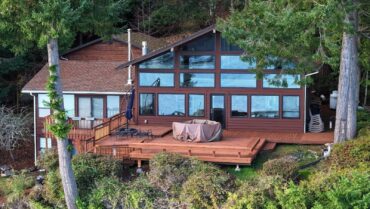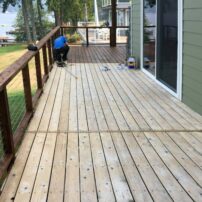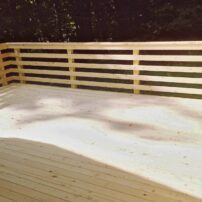The right decking material can affect the upkeep and lifespan of your deck, which will make a huge impact in the long-term cost of maintenance. For example, Trex, a composite deck board manufacturer, estimates that a pressure-treated deck can cost more than double the amount of its higher-end products over the course of 25 years due to maintenance and replacement costs. There are five common deck surface materials. Let’s explore the pros and cons of each:
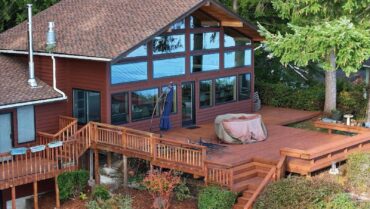
Pressure-Treated
Pressure-treated decking, also known as “sun decking” is a great low-cost option, particularly for DIYers. Pressure-treated wood in the Pacific Northwest is typically hemlock fir wood treated with alkaline copper quaternary (ACQ) solution. This solution is applied to the wood under high pressure, hence the name, and has a brownish-red hue.
I recommend always wearing gloves when working with this product and washing your hands after to ensure you do not accidentally ingest any of the chemical. Wait a season before applying any stain or treatment to it. The factory-applied chemical treatment is intended to repel liquid from the wood, which will result in poor adhesion of any stain or paint.
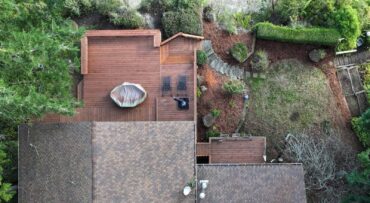
While it’s the lowest cost option, it’s also the shortest lasting option. New pressure-treated wood is not like the previous treated lumber that was coated with arsenic. Modern pressure-treated decks may need to be resurfaced in as few as five years.
- Price: $
- Pros:
Inexpensive
Easy to acquire - Cons:
Short life span
Toxic chemicals
High maintenance
Splinters (ouch!)
Very susceptible to twisting after install
Cedar
Cedar is naturally resistant to rot, which helps increase longevity. Common cedars are Western red and Alaska yellow. Alaska yellow is less common and harder to acquire, but is more dense and stronger. A cedar deck, if protected from UV and water damage, can last significantly longer than pressure-treated, with some lasting over 20 years.
If left without protection, cedar will turn a natural grey and commonly last about 10 years. While a typical cedar deck will cost less than a composite or PVC one, the additional maintenance on a cedar deck usually costs 50% or more than the higher upfront cost alternatives over the lifespan of the deck.
- Price: $$
- Pros:
Relatively inexpensive
Longer lasting - Cons:
Higher maintenance costs
Splinters
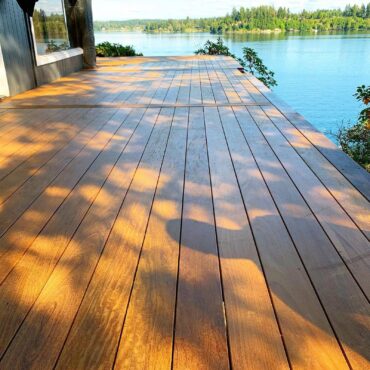
Hardwoods (Ipe, Tigerwood, Batu, Etc.)
Hardwoods come from deciduous trees and can be incredibly beautiful when completed. They are very dense and resistant to rot. They are so dense that they require specialty blades to cut them and typically a deck builder will go through a handful of these specialty blades during installation.
These types of decking products often come with grooved or square edge profiles, which allow them to be installed with mostly hidden fasteners and only a few face screws. This method enhances the beauty and saves on drill bits. Due to the dense nature of the wood, it can be challenging to stain and keep looking good. It often requires extra steps and regular maintenance.
Hardwoods typically travel a long distance to be installed here in the Pacific Northwest. Typically, these products come from South America, Asia or Africa, which increases their carbon footprint and it can be hard to know whether your deck has been sustainably sourced.
Ipe wood was used for the Coney Island boardwalks even with garbage trucks and heavy foot traffic; the surface lasted 25 years. A well protected hardwood deck could easily last longer than 30 years. If untreated, just like with cedar, it will also naturally grey, and many people find this natural look beautiful.
- Price: $$$ – $$$$
- Pros:
Long lifespan
Can use hidden fasteners - Cons:
Expense
Harder to install
Higher maintenance costs
Higher carbon footprint
May not be sourced sustainably
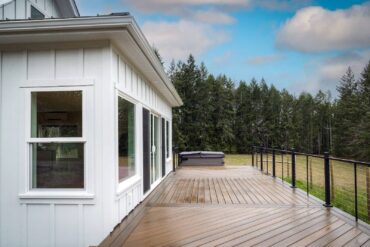
Composite
Every year, there seems to be more manufacturers providing composite decking. Composite decking is simply a product that combines wood fibers with plastic to create a deck board. Initially, Trex’s composite deck boards did not have a cap and would soak up moisture, causing staining, swelling and cracking. All modern composite now comes with a plastic cap to protect the composite core.
When installed correctly, composite is much more durable and will not easily stain, swell or crack. The hard plastic cap on most composite brands means it’s less likely to scratch, fade or stain. For example, on some of Trex’s products, there is a 50-year fade and stain warranty.
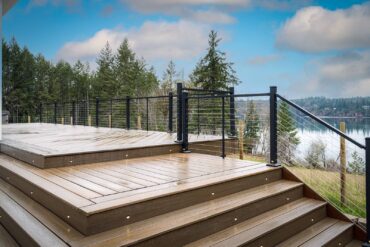
Something to keep in mind is that even though you don’t have to paint or stain the deck every year or two, it’s highly recommended that you wash the deck yearly to get pollen and other small debris off the deck. This helps ensure traction on the surface.
- Price: $$ – $$$$
- Pros:
Long lifespan
May be made from recycled plastics and may be recycled
Low maintenance
Can use hidden fasteners - Cons:
Heavy
Quality of product is very brand dependent
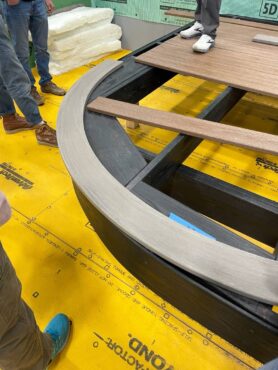
PVC
PVC (polyvinyl chloride) decking is a fully plastic material and is typically the most expensive type of decking. As with composite decking, lighter colors will be cooler to the touch in the summer months compared to darker colors. PVC decking comes in a variety of colors and sizes, and you can more easily mix, match and be creative.
PVC decking can be bent using heat to rounded shapes to create interesting patterns in lieu of a straight deck board. PVC is lighter and easier to cut and work with. Because it’s fully plastic, it will not mold or soak up moisture. Since it’s a softer material, it can be scratched more easily, which can be an issue if you have big dogs or drag heavy furniture across the deck. Fortunately, most scratches can be easily repaired by applying heat from a heat gun and using a wire brush.
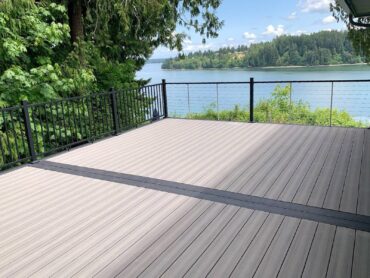
Since PVC is fully synthetic, it’s designed to last for decades, if not centuries.
- Price: $$$$
- Pros:
Low maintenance
Can use hidden fasteners
May be made from recycled PVC and may be recycled - Cons:
Easy to scratch
Higher upfront cost
Ultimately, the choice of decking will come down to your budget, your time and your style. As deck builders, our preference leans toward composite or PVC deck boards. This is because we know we’re leaving our clients with a product that will have the longest lifespan, reduce their maintenance time and cost, and have the greatest increase in their home’s value.




